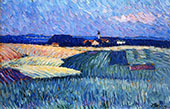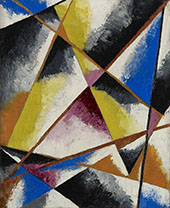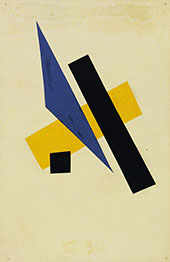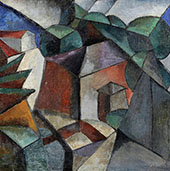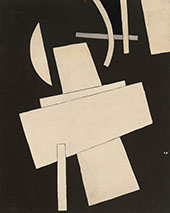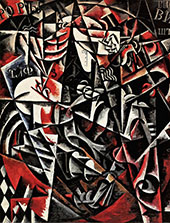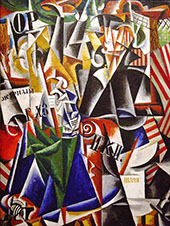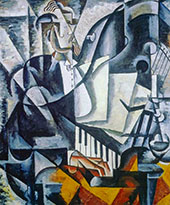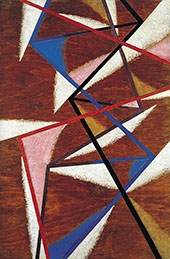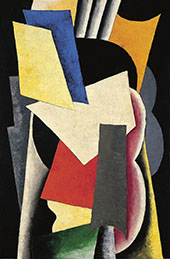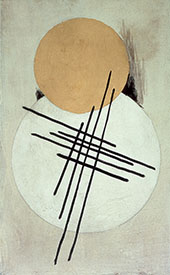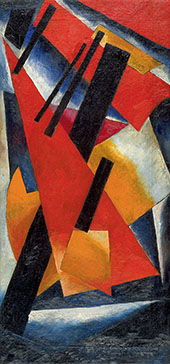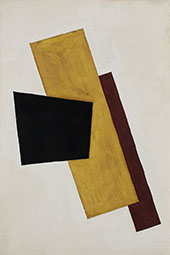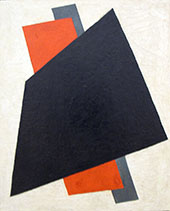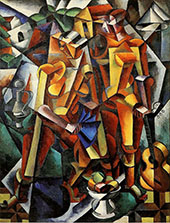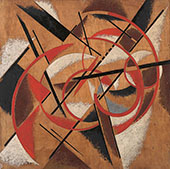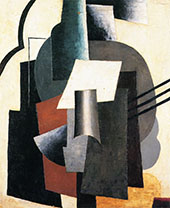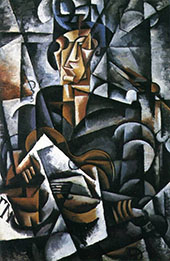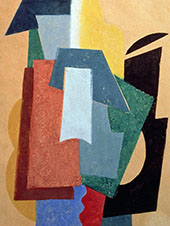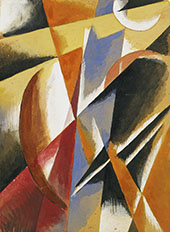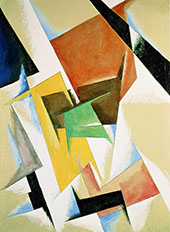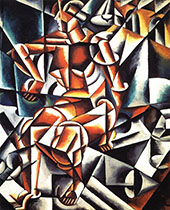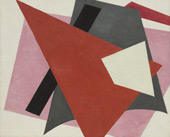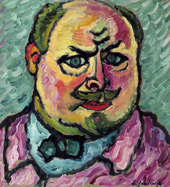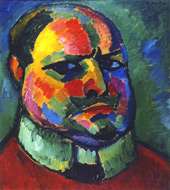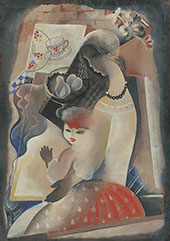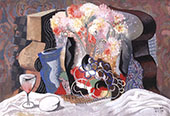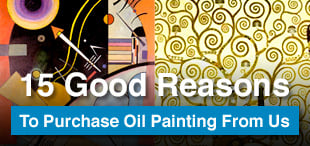Der Blaue Reiter Oil Painting Reproductions
Find Der Blaue Reiter oil painting replicas by Der Blaue Reiter artists
Der Blaue Reiter Art: A Brief Introduction
Der Blaue Reiter, translated as The Blue Rider group, came together in 1911. The leading members are Wassily Kandinsky, Paul Klee, and Franz Marc, who created some of the most famous oil paintings in European art history.
What is the Blue Rider movement?
After its foundation in 1911, the Blue Rider art movement lasted three short yet incredibly creative years. During this time, the group transformed approaches to art and influenced later Expressionist painters. As a group of like-minded creatives, Blaue Reiter artists rejected the approach of the Neue Künstlervereinigung München (NKVM). Wassily Kandinsky also founded the NKVM alongside several other artists who moved from Der Blaue Reiter group. The NKVM arranged three exhibitions before the split, with famous paintings by Pablo Picasso and George Braque contributing. Nonetheless, several members left due to tensions in the group. Kandinsky felt the NKVM needed to be more traditional and relaxed in its artistic approach. He and other artists launched a parallel show in the Moderne Galerie in Munich in 1911. This exhibition heralded Der Blaue Reiter’s opposing focus.
What is the meaning of Der Blaue Reiter?
Der Blaue Reiter art stems from an Exhibition held by Wassily Kandinsky and Franz Marc. The Blue Rider artists brought individual emotion and spirituality into art, contrasting with the time's stricter, more conservative approaches. The group needed a formal artistic manifesto, and their paintings required meaning. Nonetheless, some common characteristics include:
- Bright coloring, often contrasting yellows, reds, greens, and blues.
- Simplistic, stylized forms, taking inspiration from Medieval art and Primitivism.
- A focus on emotional and spiritual communication rather than symbolic representation.
- Spontaneous and expressive bold brushstrokes which are freely applied
Some scholars believe the group’s unusual name derives from a Wassily Kandinsky painting, Blue Rider 1903. The oil painting shows a horse rider wearing a vivid blue cloak, rapidly galloping through a green field. A forest is visible in the background, with leaves gently turning to oranges and reds. The sky is an azure blue with two clouds lazily floating past. In the foreground and on the horizon, deep dark blue shadows seep onto the canvas. Despite this, Kandinsky later described its origins as Franz Marc’s love of horses, Kandinsky’s love of riders and riding, and the two artists sharing an appreciation for the color blue.
What does the Blue Rider painting represent?
Whatever the origin of the Der Blaue Reiter name, art historians still debate what Kandinsky’s Blue Rider painting stands for. Aside from the literal content, The Blue Rider 1903 displays Kandinsky’s shift from Impressionism to Modern Abstract Art. Blue Rider evidences early signs of abstraction and simplified forms that characterized Kandinsky’s later oil paintings. Indeed, while paintings such as Landscape 1913 and Composition VIII 1923 focus on simple shapes, primary colors, and dynamic movement, The Blue Rider painting contains early hints of these ideas.
What did the Blue Rider group do?
While the aims and approaches of each Blaue Reiter artist differ, they all attempt to express spiritual truths in their art. This is achieved primarily through the symbolic and spiritual associations of color, most notably blue. For Kandinsky, the color blue represents esoteric truths and spirituality. The darker the shade of blue, the more it links with eternity and the human desire for truth. The Blue Rider group strongly supported and championed Modern Art activities. They celebrated connections between music, life, and art. In addition, they launched a highly intuitive and spontaneous method of painting. As a result, they organized several popular touring exhibitions in Germany. The group issued an almanac in early 1912, Edited by Kandinsky and Franz Marc. Der Blaue Reiter Almanac features poetry, essays, and primitive folk art alongside contemporary developments such as Cubism, Expressionist Art, and Fauvism. The Blue Rider artists planned a second volume, but World War I intervened.
Which artists were members of Der Blaue Reiter group?
Wassily Kandinsky founded Der Blaue Reiter group alongside several Russian and German artists, including Alexej von Jawlensky and Marianne von Werefkin, who were Russian emigres. German painters such as Gabriele Munter, Franz Marc, August Macke, and Paul Klee joined the group. Several lesser-known members included Albert Bloch, Clotilde von Derp, Lyonel Feininger, and Natalia Goncharova.
Here are five leading Der Blaue Reiter artists and some of their most famous artworks:
Wassily Kandinsky 1866-1944
As the leading painter and theorist of the Der Blaue Reiter, Wassily Kandinsky paintings mainly define the art movement. His early paintings were relatively conventional from 1911 onwards. After this point, Kandinsky avoided direct representations of worldly objects and figures and focused on color and form. For this reason, he is one of the early pioneers of Abstract Art. Kandinsky paintings were often Improvisations or Compositions referencing links with music. Famous oil paintings are Improvisation 23 1911, Improvisation 30 Cannons 1913, and the extraordinarily colorful painting Composition VII 1913.
Franz Marc 1880-1916
A key member of Der Blaue Reiter art group is Franz Marc. As his career progressed, he painted animals using vivid, bright colors with broad, flowing brushstrokes. Franz Marc paintings, Blue Horse 1911 and Large Blue Horses, also 1911, are some of his famous artworks. The colors are deeply symbolic, with rolling red tones accentuating violent emotions. The reds and yellows contrast with the calm serenity of the blue horses, ominously threatened by the shifting, flowing landscapes behind. Sadly, Franz Marc died fighting at the Battle of Verdun in 1916.
August Macke 1887-1914
August Macke is a fascinating Blue Rider artist. His early style developed with influences from French Impressionism and Fauvism, as seen in oil paintings such as Anglers on the Rhine in 1905. Nonetheless, Macke shifted towards non-objective painting, focusing on symbolism and mysticism through his associations with Franz Marc and Kandinsky. August Macke also incorporated Futurism and Cubist principles in his painting. Unusual townscapes such as Large Bright Shop Window 1912 particularly represent Macke’s Cubist inspiration. Later paintings, such as Lady in Green Jacket 1913, exemplify his colorful yet softer Fauvist compositions. August Macke also died during World War One. He died serving in Champagne, France, on 26 September 1914.
Paul Klee 1879-1940
Paul Klee paintings straddle multiple art movements. He transformed European art by working with, Expressionist, Bauhaus, Cubist, and Surrealist approaches and his membership in Der Blaue Reiter Group. Writings by Paul Klee on color theory, "Paul Klee Painted Notebooks," are foundational texts of contemporary art. Paul Klee and Kandinsky taught at the Bauhaus School of Art, Design, and Architecture, influencing future generations of artists. Klee commented on their friendship and felt a deep trust in Kandinsky due to his excellent and lucid mind. The Paul Klee paintings reflect his infamous dry humor and intelligence. Famous oil paintings by Paul Klee, such as Castle and Sun 1928 and Senecio 1922, elevate the simplicity and beauty of everyday subjects to create famous abstract paintings.
Alexej von Jawlensky 1864-1941
Last but not least, in this introduction to Der Blaue Reiter artist is Alexej von Jawlensky. He met Marianne von Werefkin in St Petersburg, and the couple moved to Munich in 1894. Here they met Kandinsky and Gabriele Münter. Becoming close friends, they all contributed to the Neue Künstlervereinigung München before its split to form the Blue Rider Group. Characteristic Jawlensky paintings of this era include a pair of particularly colorful self-portraits, both painted in 1912. During the war, this developed into more abstract creations such as Variation When The Lark is Singing and the later iconic Mystical Heads series and abstract paintings of Christ.
When did the Blue Rider movement end?
Despite their pioneering work, their work ended abruptly with the outbreak of the First World War in 1914. Both August Macke and Franz Marc died in combat. As Russian citizens, Marianne von Werefkin, Alexej von Jawlensky, and Kandinsky returned to Moscow during the outbreak of hostilities. After peace returned to Europe, Kandinsky formed The Blue Four (Die Blaue Vier) in 1923. Alongside Jawlensky, Feininger, and Paul Klee, supported by their art dealer, Galka Scheyer, the four toured America from 1924 onwards. They kept the original focus of Der Blaue Reiter group for several years but later went their separate ways.
Der Blaue Reiter Art: Reproduction Oil Paintings
If you love the colorful paintings of Der Blaue Reiter art, explore our extensive collection of hand-painted replica art. Whether your preference is for Wassily Kandinsky paintings, Franz Marc’s Blue Horse paintings, or the art of Paul Klee, select your favorite famous paintings from 30,000+ fine art reproductions.
Testimonial from Nicky N, Holland
Cannot Find What You Are Looking For?
Reproduction Gallery Information
Customer Service
(Send Us A Message)
Tel: (503) 937 2010
Fax: (503) 937 2011

